b. The Key Laboratory of Chemistry for Natural Products of Guizhou Province, Chinese Academy of Sciences, Guiyang, 550014, China;
c. Department of Chinese Medicine Resources and Development, College of Pharmacy, Guizhou University of Traditional Chinese Medicine, Guiyang, 550025, China;
d. Key Laboratory of Economic Plants and Biotechnology, Kunming Institute of Botany, Chinese Academy of Sciences, Kunming, 650201, China;
e. State Key Laboratory of Phytochemistry and Plant Resources in West China, Kunming Institute of Botany, Chinese Academy of Sciences, Kunming, 650201, China
Dragon Boat Festival (Duanwujie in Chinese) is celebrated in China on the fifth day of the fifth lunar month of the year. According to a pre-Qin Dynasty (201-206 BCE) text on the origins of the Dragon Boat Festival, orchid-plants are collected for bathing in the fifth lunar month of each year in order to strengthen the human body and remove diseases (Yan, 2005). Moreover, folk custom contends that the fifth lunar month is a "bad month" and encourages people to cleanse themselves with herbs during the Dragon Boat Festival to get rid of diseases and keep fit (Liu, 2013). Today, ethnic minorities in southern China continue to collect and use herbal medicines during the Dragon Boat Festival, which has led to the establishment of festival herbal markets.
The Buyi ethnic group in southern China uses fresh herbs to prevent and treat diseases. The Buyi mainly inhabit the Qianxinan Buyi and Miao Autonomous Prefecture in southwestern Guizhou Province. The history of Dragon Boat Festival herbal markets in this area can be traced over 2000 years. This tradition began with villagers bringing medicinal herbs to the market for sale and exchange on Dragon Boat Festival, but has gradually become a fixed herb market. Local people believe that herbs have the greatest medicinal power and curative effect around the time of the Dragon Boat Festival and local tradition holds that visiting the herb market and inhaling the smell of herbs on the day of the Dragon Boat Festival prevents sickness for a year (Yuan, 2013).
Previous studies have investigated the use of medicinal plants around the time of Dragon Boat Festival in Jingxi and Gongcheng of Guangxi Zhuang Autonomous Region (Yang et al., 2009; Lin et al., 2016), Pu'er City in Yunnan Province (Liu et al., 2016), Bijie Prefecture in Guizhou Province (Yang et al., 2015), and Jianghua County in Hunan Province (Jin et al., 2018; Luo et al., 2018). These studies have characterized the species diversity of medicinal plants and their medicinal parts, medicinal purposes, modalities, and other information (Luo et al., 2018). However, during the last half century, traditional culture of ethnic minority groups has been greatly impacted by modern development and is currently being lost in many areas. Therefore, it is important to continue documenting the scientific value of the traditional herb market on Dragon Boat Festival. This is especially critical for our understanding of how these markets maintain bio-cultural diversity.
In this study, we evaluate the biodiversity and analyze the characteristics of the Qianxinan Dragon Boat Festival herbal markets. Our survey results provide a reference for the conservation of local biodiversity and the inheritance of ethnic medicine culture.
2. Materials and methods 2.1. Study siteThe Qianxinan Buyi and Miao Autonomous Prefecture is located in southwest Guizhou Province. The total population of the prefecture is 3, 117, 300, of which 29.68%, or 925, 000, are Buyi (Ren et al., 2014). We selected the herbal markets of Zhenfeng and Xingren as study sites (see Fig. 1). These two herbal markets are representative Dragon Boat Festival herbal market in Qianxinan Buyi and Miao Autonomous Prefecture. The markets start three days before the Dragon Boat Festival and grow to their largest on the festival day. Zhenfeng County is located on the banks of the Beipan River, situated in a karst mountainous area that declines in elevation from northwest to southeast. Zhenfeng County has a fragile ecology with a plateau-type north subtropical temperate humid monsoon climate, an annual average temperature between 18.4 and 19.5 ℃, annual rainfall of less than 1356 mm, an annual average relative humidity of 81%, and average annual sunshine duration higher than 1418 h (Liu et al., 2009). Xingren City (25°16'-25°48'N, 104°54'-104°54'E) is adjacent to Zhenfeng County and shares a similar climate. Xingren City also has abundant rainfall, with an average annual precipitation of 1320.5 mm, 85% of which occurs during the rainy season (1116.3 mm). The annual average frost-free period is 281 d, an annual average relative humidity of 78%, and the annual average temperature is 15.2 ℃ (Pang et al., 2016). This region hosts over 3900 vascular plant species, of which 300 spp. are rare and about 1770 are used as Chinese herbal medicine (Yang et al., 2019).
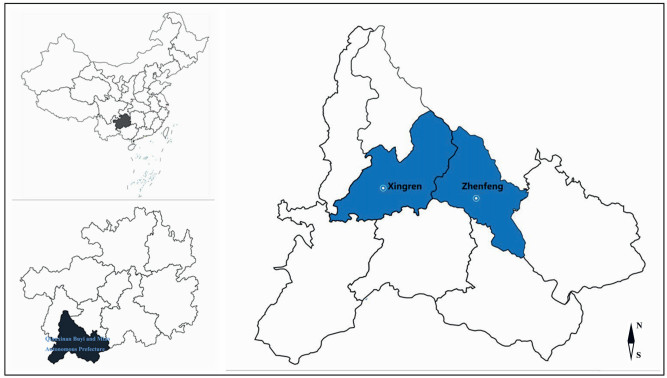
|
| Fig. 1 A map of the study area. |
Ethnobotanical surveys were carried out at herbal markets in the county-level towns of Xingren and Zhenfeng in the Qianxinan Buyi and Miao Autonomous Prefecture during the Dragon Boat Festival from June 4-8, 2019 and June 22-27, 2020. The informants were traders and purchasers at the Dragon Boat Festival herbal markets. Semi-structured interviews were conducted with 48 vendors and purchasers in Xingren and 59 vendors and purchasers in Zhenfeng. Informants included men (48.6%) and women (51.4%). Due to the time constraints of the market, all vendors were selected on a voluntary basis.
The Dragon Boat Festival herbal markets differ from markets in the area that routinely trade herbs on weekends. Only fresh herbs are sold at the Dragon Boat Festival herbal markets. These fresh herbs are collected one or two days before Dragon Boat Festival to maximize the efficacy of the medicinal plants. Thus, interviews focused on fresh plants traded in the market. The main interview questions were about parts of the plant, medical functions, and how to use them.
All the fresh plant samples collected in the market were identified according to the Flora Reipublicae Popularis Sinicae (China Flora Editorial Board, 2004). Voucher specimens of the medicinal plants were collected and deposited at the herbarium of State Key Laboratory of Chemistry for Natural Products of Guizhou Province and Chinese Academy of Sciences. The information collected about the medicinal plants included Latin name, Chinese name, vernacular name, family name, life form, plant parts used, preparation method, and medicinal uses.
2.3. Statistical analysisTo the importance and use of medicinal plants investigated at the Dragon Boat Festival herbal markets, we used Relative Importance (RI) and utilization frequency indices.
2.3.1. Relative importance valueRelative importance value (RI) was initially proposed by Bennett and Prance (2000), after that the calculation of "relative importance" was simplified as follows:

|
where NUC is the number of use-categories of a given species (NUCS) divided by the total number of use-categories of the most versatile species (NUCVS); NT is the number of types of uses attributed to a given species (NTS) divided by the total number of types of uses attributed to the most important taxon (NTMIT), independent of the number of informants that cite the species (Albuquerque et al., 2006; Huai and Khasbagan, 2010). During this study, NUC was equated to the number of types of therapeutic modalities (NM) of a given species divided by the number of all modalities. Thus, RI is the sum of the NM and NT as the following formula (Luo et al., 2018).

|
The utilization frequency per species was estimated by calculating the proportion of plants mentioned by their vernacular names (using its scientific name) with respect to the total number of the interviews. The formula of "utilization frequency" is

|
where f is the utilization frequency of a certain plant, Nm is the number of times providers refer to the plant, and Ni is the total number of information providers. For a given plant, a high f value indicates a high utilization frequency (Ladio and Lozada, 2001; Huai and Khasbagan, 2010).
3. Results and discussion 3.1. Age, gender, and education of informantsA total of 107 informants were interviewed, including both men (48.6%) and women (51.4%) (Table 1). The ages and educational levels of the informants varied. Most informants were between 45 and 80 years old. 42.1% percent of the informants had no education, 32.7% had an elementary education, 16.8% had a secondary level, and 8.4% had a high school education; no informants had a university education. Some of the older informants could not read or do basic arithmetic. Most of the informants collect and sell medicinal plants to subsist. However, a few of the younger traders buy herbal materials from other drug collectors and sell them to pharmaceutical companies or large merchants.
| Variables | Informant Category | Number | % of informants |
| Gender | Male | 52 | 48.6 |
| Female | 55 | 51.4 | |
| Age-class | 20-30 | 6 | 5.6 |
| 30-45 | 22 | 20.6 | |
| 45-60 | 42 | 39.2 | |
| 60-80 | 37 | 34.6 | |
| Education Level | Illiteracy | 45 | 42.1 |
| Elementary education | 35 | 32.7 | |
| Junior middle school education | 18 | 16.8 | |
| High school education | 9 | 8.4 | |
| Tertiary education | 0 | 0 |
This study recorded 141 medicinal plant species belonging to 114 genera and 61 families that are used to treat more than 52 ailments (Table S1). The taxonomic composition (family and genus level) of traditional medicinal plants was highly diverse, with a large number of single-species families and genera. The plant family with the most species represented was Asteraceae (14 species), followed by Liliaceae (11 species), Orchidaceae (8 species), Rosaceae (5 species), Guttiferae (4 species), Leguminosae (4 species), Labiatae (4 species) and Berberidaceae (4 species), with each of the remaining families represented by only 1-3 species. These species are scattered in different families and genera, reflecting the high biodiversity of the region.
The life forms of fresh medicinal plants sold at the Dragon Boat Festival herbal markets mainly include herbs (69.5%), followed by shrubs (14.2%), tree (5.7%), woody vine (5.7%) and herbaceous vine (4.9%) (Fig. 2). The plant parts sold with the highest frequency at the Dragon Boat Festival herbal markets is whole plant (51.8%), followed by the roots (15.6%) and aerial parts (9.2%) (Fig. 3). In addition, other parts of some plants, such as flowers, fruits, stems and bulbs are also sold in small quantities at the herbal markets. Two important cultural plants symbolic of Dragon Boat Festival, Artemisia argyi and Acorus calamus, are the most sold plants in the Dragon Boat Festival herbal markets. Since ancient times, people have believed that hanging ai hao (A. argyi) and chang pu (A. calamus) on the door can get rid of evil and aliments. Collecting A. argyi is an important folk activity of the Dragon Boat Festival that has been passed down from ancient times to the present (Mei, 2010). Both A. argyi and A. calamus are fragrant herbs. Their fragrance can dispel mosquitoes. In addition, A. argyi and A. calamus baths are used to cure some skin diseases and diseases caused by summer heat.
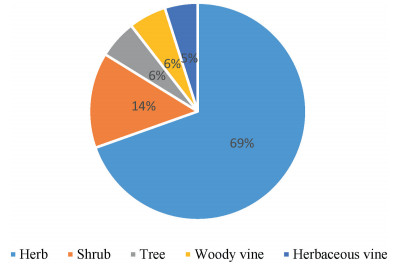
|
| Fig. 2 The life forms of fresh medicinal plants sold at Dragon Boat Festival herbal markets Qianxinan Buyi and Miao Autonomous Prefecture. |
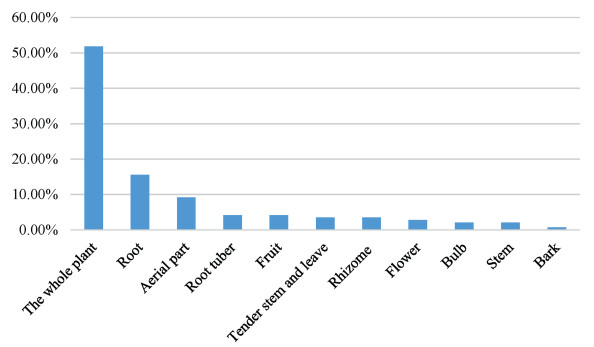
|
| Fig. 3 The plant part (%) sold in Dragon Boat Festival herbal markets of Qianxinan Buyi and Miao Autonomous Prefecture. |
The fresh medicinal plants sold in Dragon Boat Festival herbal markets are roughly divided into 10 categories (Table 2). Of these, 95.7% of the plants are used for decoction, and 30.5% are used for medicinal baths. The use of medicinal baths is related to both cultural and environmental factors. Medicinal baths are a tradition inherited from the original Duanwujie that has been conserved by the traditional culture of the ethnic minority communities in this region. Informants report that the properties of herbs during Dragon Boat Festival are the most powerful of the year. In addition, the wet weather in the region exposing people to higher risks of rheumatism, which is treated by medicinal baths. This tradition is consistent with studies that have suggested herbal medicated bath therapy may be helpful in the treatment of pain symptoms in patients with knee osteoarthritis and gynecopathy (Lucena et al., 2007; He, 2008; Chen et al., 2009, 2014; Panyaphu et al., 2012). Although several reports on the investigation of the Dragon Boat Festival herbal market have discussed the plants used for medicinal bath (Yang et al., 2009, 2015; Luo et al., 2018), the plants or formulas of medicinal bath in each place are different due to the influence of local plant species and medical culture. In the Dragon Boat Festival herbal markets of Qianxinan Buyi and Miao Autonomous Prefecture, some stalls are equipped with bundles of medicinal bath formulas. For example, the branches and leaves of Hedera nepalensis var. sinensis, Hypericum monogynum, Lycopodium japonicum, and Senecio scandens are a common medicinal bath formula. Another formula consists of the branches and leaves of Blumea balsamifera, Liquidambar formosana and S. scandens, which is a fixed formula used to treat rheumatic arthritis or postpartum fatigue in women. Characteristic medicinal plants used locally as medicinal bath herbal materials include H. monogynum, B. balsamifera and L. formosana.
| Therapeutic modalities | Record number | Percentage | Therapeutic modalities | Record number | Percentage |
| Decoction | 135 | 95.7 | Substitute for tea | 5 | 3.5 |
| Medicinal bath | 43 | 30.5 | Herbal food | 6 | 4.2 |
| External application | 27 | 19.1 | Coloring agent | 3 | 2.1 |
| Vegetable | 8 | 5.7 | Fruits | 2 | 1.4 |
| Soak in alcohol | 5 | 3.5 | Hung on the door | 2 | 1.4 |
The types of diseases treated by medicinal plants traded in the Dragon Boat Festival herbal markets can be classified into 10 categories (Fig. 4). Most diseases treated by medicinal plants are related to rheumatism, injuries, the digestive system and the respiratory system, most of which are common in the local population. The most common ailments are rheumatoid and injuries. People in this region also process some medicinal herbs into plasters to treat rheumatic pain. Consequently, herbal plasters are a major characteristic of local ethnomedicine, with some plants use for more than one medical purpose. The efficacy of medicinal plants varies due to the complexity of components and the diverse characteristics of its targets. This suggests that more research should focus on the synergistic effect of ethnomedicine and the mechanisms of multiple disease targets in the future.
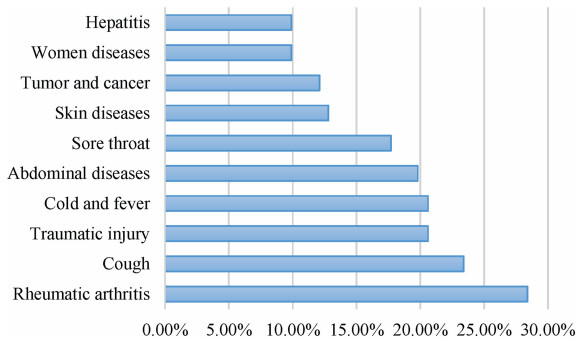
|
| Fig. 4 The top ten medicinal uses of medicinal plants (%) at Dragon Boat Festival herbal markets. |
The ten most frequently traded species sold at the market range in price between CNY 2 per kilogram (Piper sarmentosum) to CNY 12 per kilogram (Mahonia fortunei) (Fig. 5). These ten plants include the most common medicinal bath materials and cultural supplies for the Dragon Boat Festival. In recent years, due to the over-exploitation of wild plant medicines, many wild plant resources have declined sharply. The price of herbs at the market is an indicator of which wild resources are endangered and in urgent need of protection. The ten most expensive fresh herbs traded in the Dragon Boat Festival herb markets (> CNY 100 per kilogram) include Paris polyphylla, Viola szetschwanensis, Gastrodia elata, Dendronbium orchids and Bletilla bulbs (Fig. 6).

|
| Fig. 5 Prices per kilogram (CNY per kilogram) sold of the ten most frequently traded species at Dragon Boat Festival herbal markets. |
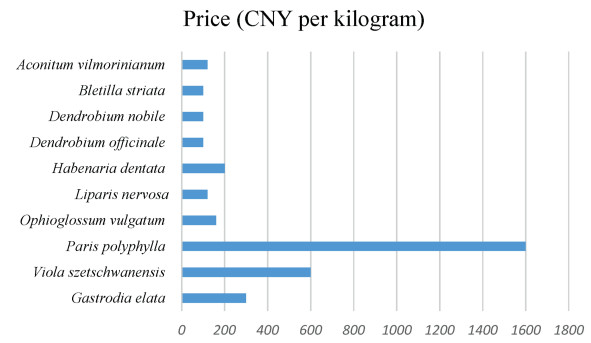
|
| Fig. 6 Prices per kilogram (CNY per kilogram) sold of the ten most expensive traded species at Dragon Boat Festival herbal markets. |
Ten of the most frequently used medicinal plants are summarized in Table 3. The species with the highest f-index values were Artemisia argyi and Acorus calamus, indicating that they are the most frequently used plants during the Dragon Boat Festival. These two plants are not only important, culturally symbolic plants during the Dragon Boat Festival, but also have high medicinal value, including treatment of inflammation, skin diseases and abdominal diseases. The two species are also very important herbal bath materials. In addition, Hedera nepalensis var. sinensis, Taraxacum mongolicum, and Hypericum monogynum all showed high f-index values, and are also commonly used medicinal bath plant materials in the region. These plants are mainly used to treat or relieve rheumatic pain, with T. mongolicum used as a heat clearing and detoxifying folk medicine.
| Scientific name | Functions | Usage | f-index |
| Artemisia argyi Lévl. et Van. | Anti-inflammatory, cough suppressant, antiallergen | Medicinal bath, decoction, hung on the door | 0.90 |
| Acorus calamus L. | The rhizome is used to treat epilepsy, nervous prostration, abdominal diseases, rheumatism | Medicinal bath, decoction, hung on the door | 0.69 |
| Hedera nepalensis K. Koch | Rheumatism, traumatic injury, hepatitis, apoplexia, skin diseases | Medicinal bath, decoction, external application | 0.64 |
| Taraxacum mongolicum Hand.-Mazz. | Mastitis, scrofula, conjunctivitis, cold and fever, hepatitis | Decoction, vegetable | 0.58 |
| Hypericum monogynum L. | Hepatitis, sore throat, epipephysitis, injuries | Decoction, medicinal bath | 0.58 |
| Blumea balsamifera (L.) DC. | Cold and fever, sore throat, skin diseases, rheumatism | Decoction, medicinal bath | 0.58 |
| Liquidambar formosana Hance | Rheumatic arthritis | Medicinal bath, dying | 0.56 |
| Plantago depressa Willd. | Fever, dysuria | Decoction | 0.56 |
| Houttuynia cordata Thunb. | Cold, pneumonia | Vegetable, Decoction | 0.56 |
| Hypericum kouytchense Lévl. | Hepatitis, sore throat, epipephysitis, injuries | Decoction, medicinal bath | 0.55 |
The relative importance value of medicinal plants reflects their comprehensive application value (Albuquerque et al., 2006). Fifteen plants have RI value greater than 1.0 (Table 4), which indicates that these plants have many medicinal uses. Ten of these species are common medicinal bath plants. These species are common in the region, and are often used by local herbalists and residents. Five of these plants are edible and medicinal plants, including Dendrobium nobile and Dendrobium officinale, which can be mixed into a prescription, but also can be used to make tea. Other species, are both prescribed and used in local dishes that act as tonics (e.g., chicken or pig's feet soup). Dietotherapy, which is also a major feature of Chinese traditional culture, is reflected in the local herbal food culture.
| Scientific name | Functions | Therapeutic modalities | RI |
| Achillea wilsoniana Heimerl ex Hand.-Mazz. | Rheumatism, traumatic injury | Decoction, external Application, medicinal bath | 1.30 |
| Acorus calamus L. | The rhizome is used to treat epilepsy, nervous prostration, abdominal diseases, rheumatism | Medicinal bath, decoction, hung on the door | 1.30 |
| Artemisia argyi Lévl. et Van. | Anti-inflammatory, cough suppressant, anti - allergen | Medicinal bath, decoction, hung on the door | 1.30 |
| Cibotium barometz (L.) J. Sm. | Analeptic, hemostatics | Decoction, external application, soak in alcohol | 1.30 |
| Dendrobium nobile Lindl. | Pulmonary tuberculosis, cough, sore throat | Decoction, external application, substitute for tea | 1.30 |
| Dendrobium officinale Kimura et Migo | Pulmonary tuberculosis, cough, sore throat | Decoction, external application, substitute for tea | 1.30 |
| Disporopsis fuscopicta Hance | Cough, traumatic injury, Postpartum fatigue | Decoction, medicinal bath; herbal food | 1.30 |
| Drynaria roosii Nakaike | Traumatic injury, rheumatic arthritis, toothache | Medicinal bath, decoction, soak in alcohol | 1.30 |
| Fallopia multiflora (Thunb.) Harald. | Fresh root: scrofula, hyperlipemia, constipation, skin diseases; Radix Polygoni Multiflori Preparata: premature graying of hair, dizziness and tinnitus, numbness of the limbs, weakness |
Decoction, external application, soak in alcohol | 1.30 |
| Hedera nepalensis var. sinensis (Tobl.) Rehd. | Rheumatism, traumatic injury, hepatitis, apoplexia, skin diseases | Medicinal bath, decoction, external application | 1.30 |
| Polygonatum kingianum Coll. et Hemsl. | Weakness, cough | Decoction, herbal food, soak in alcohol | 1.30 |
| Talinum paniculatum (Jacq.) Gaertn. | Roots: Nourishing medicine Leaves: skin diseases |
Decoction, medicinal bath, herbal food | 1.30 |
| Piper sarmentosum Roxb. | Fresh root: traumatic injury, rheumatic arthritis; Leaves: traumatic injury, skin diseases |
Medicinal bath, decoction, external application | 1.30 |
| Plumbago zeylanica L. | Fresh root: traumatic injury, rheumatic arthritis; Leaves: traumatic injury, skin diseases |
Medicinal bath, decoction, external application | 1.30 |
| Dicliptera chinensis (L.) Juss. | Cold and fever, herpes zoster | Decoction, external application, medicinal bath | 1.30 |
Herbal markets are effective mediums for transmitting ethnomedicinal knowledge and traditional culture. Furthermore, this traditional knowledge reflects the accumulated experience and wisdom of people from ancient times that struggled with harsh environmental and climatic factors. This study documents the use of plant diversity in the traditional medicine of the Qianxinan Buyi and Miao Autonomous Prefecture in southwestern China. Herbal plants are most commonly used in this region to treat rheumatic diseases. This use of herbal plants is an eco-cultural adaptation of local people to the humid environment and seasonal changes.
Our interviews identified 141 fresh medicinal plant species belonging to 61 families that are used to treat more than 52 ailments. Most common herbal medicine prices range between CNY 2-12 per kilogram; however, some precious herbal medicine prices are more than CNY 100 per kilogram, especially rare herbs such as wild Paris polyphylla and Gastrodia elata, which are priced much higher. The price of medicinal fresh materials sold in the market may serve as an indicator of the conservation status of plants within the region. If so, these indicators can be used to develop strategies in collaboration with local communities to domesticate and protect rare and endangered medicinal herbs. In addition, relative importance analysis identified plants that are useful for daily health care and medicine in the region. These wild medicinal plants, which have significant curative effect, should be further studied.
Author contributionsG.W., P.S.J. and H.X.J. designed the experiments. G.W., W.Z.H., Z.J.Y. and H.L.J. participated in the investigation and specimen collection of the filed. G.W. wrote the manuscript.
Declaration of Competing InterestThe authors declare no competing financial interest.
AcknowledgementsThis work was supported by the grants from the National Natural Science Foundation of China (31860074, U1812403); the Science and Technology project of Guizhou Province (QKHZC[2018]2799); and Guizhou Province Engineering Research Center for Natural Drugs.
Appendix A. Supplementary dataSupplementary data to this article can be found online at https://doi.org/10.1016/j.pld.2020.12.010.
Albuquerque U.P., Lucena R.F.P., Monteiro J.M., et al, 2006. Evaluating two quantitative ethnobotanical techniques. Ethnobot. Res. Appl, 4: 51-60. DOI:10.17348/era.4.0.51-60 |
Bennett B.C., Prance G.T., 2000. Introduced plants in the indigenous pharmacopoeia of northern South America. Econ. Bot, 54: 90-102. DOI:10.1007/BF02866603 |
Chen B., Chung M., Zhan H., et al, 2014. Traditional Chinese herbal medicated bath therapies for osteoarthritis. Osteoarthritis Cartilage, 22: S57-S489. |
Chen H.Y., Shoumura S., Emura S., et al, 2009. Tibetan medicated-bath therapy may improve adjuvant arthritis in rat. eCAM, 6: 211-217. |
China Flora Editorial Board, 2004. Flora Reipublicae Popularis Sinicae. China: Science Press.
|
He, T., 2008. Medicinal Bath Apparatus for Treating Gynecopathy. CN-201085773-Y.
|
Huai H.Y., Khasbagan, 2010. Quantitative methods in ethnobotany (II). J. Inner Mongolia Normal Univ.(Nat. Sci. Ed.), 39: 417-419. |
Jin B., Liu Y.J., Xie J.X., et al, 2018. Ethnobotanical survey of plant species for herbal tea in a Yao autonomous county (Jianghua, China): results of a 2-year study of traditional medicinal markets on the Dragon Boat Festival. J. Ethnobiol. Ethnomed, 14: 58. DOI:10.1186/s13002-018-0257-0 |
Ladio A.H., Lozada M., 2001. Nontimber forest product use in two human popultaions from northwest Patagonia: a quantitative approach. Hum. Ecol, 29: 367-380. DOI:10.1023/A:1013199103440 |
Lin C.R., Lu Z.C., Liu J., et al, 2016. Investigation of medicinal plants on medicinal market during dragon-boat festival in Gongcheng yao autonomous county of Guangxi. Mod. Chin. Med, 18: 730-736. |
Liu G.Y., 2013. Dragon Boat festival medicinal custom. Yi Shi Can Kao, 6: 65. |
Liu R.X., Wang Z.H., Zhang Z.H., 2009. Ecological characteristics of bryophyte communities from Karst rock desertification peak cluster in Zhenfeng of Guizhou Province. Bull. Bot. Res, 29: 734-741. |
Liu Y.Y., Yao X., Li H.T., et al, 2016. Ethnobotanical study of medicinal plants around the time of Duanwu Festival in Pu'er City. Chin. J. Ethnomed. Ethnopharmacy, 25: 128-131. |
Lucena R.F.P., Araujo E.L., Albuquerque U.P., 2007. Does the local availability of woody caatinga plants (Northeastern Brazil) explain their use value. Econ. Bot, 61: 347-361. DOI:10.1663/0013-0001(2007)61[347:DTLAOW]2.0.CO;2 |
Luo B.S., Liu Y.J., Liu B., et al, 2018. Yao herbal medicinal market during the dragon Boat festival in Jianghua county, China. J. Ethnobiol. Ethnomed, 14: 61. DOI:10.1186/s13002-018-0260-5 |
Mei J.J., 2010. The change and cultural thinking of the custom of "collecting Artemisia argyi" in Dragon Boat Festival. Heilongjiang Shi Zhi, 1: 132-133. |
Pang W.P., Qin F.X., Lv Y.C., et al, 2016. Chemical speciations of heavy metals and their risk assessment in agricultural soils in a coal mining area from Xingren County, Guizhou Province, China. Chin. J. Appl. Ecol, 27: 1468-1478. |
Panyaphu K., Sirisaard P., Ubol P., et al, 2012. Phytochemical, antioxidant and antibacterial activities of medicinal plants used in Northern Thailand as postpartum herbal bath recipes by the Mien (Yao) community. Phytopharmacology, 2: 92-105. |
Ren A.Y., Pu P., Pan S.H., et al, 2014. Preliminary study on wild edible plants of Buyi nationality in southwest Guizhou. J. Kaili Univ, 32(3): 52-58. |
Yan B., 2005. The historical otigin of the Dragon Boat Festival and the formation of its customs. J. Xi0An Univ. Arts Sci.: Soc. Sci. Ed, 6: 40-42. |
Yang C.Y., Long C.L., Shi Y.N., et al, 2009. Ethnobotanical study on medicinal market during dragon Boat festival in Jingxi county. Southwestern Guangxi region. Journal of the CUN: J. Nat. Resour. Life Sci. Educ, 2: 16-26. |
Yang W.Z., Jin H., Xu Z.L., et al, 2015. Ethnobotanical study on medicinal market during dragon Boat festival in Bijie region of Guizhou. J. Plant Genet. Resour, 2: 222-230. |
Yang Y., Wu L.L., Yao T.Y., Gong X.W., Yan F., 2019. Research status and key technology analysis of comprehensive development of traditional Chinese medicine resources in Southwestern Guizhou. Zhong Guo Wei Sheng Chan Ye, 6: 185-187. |
Yuan Z.Z., 2013. Jingxi, millennium herbal market from the land of herbs. Wen Hua Zhong Guo, 11: 42-47. |



